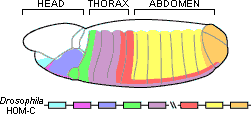Going from a simple fertilized egg cell to a fly over the course of a few weeks is an amazing transformation. A lot of things have to happen: the body form must be laid out (head/tail, back/belly), different tissues must be built, and organs must be grown. The adult fly is composed of a lot of very different parts made of different cells — yet every cell carries the same genetic instructions. So how does it “know” what to do?
- Certain genes control where and when other genes are expressed
Not all genes code for “building material” proteins (such as keratin that makes up part of your skin, or rhodopsin that makes eyes sensitive to light). Regulatory genes control when and where other genes get turned on. For example, these sorts of genes tell the cells of the fly when and where to start building wings. This occurs during the larval stage on the second and third segments of the thorax. Regulatory genes can start a “chain reaction” of effects, turning on and off other genes, whose products affect other genes, whose products in their turn affect other genes, and so on. A single regulatory gene can thus control the construction of a body part as complex as a leg or eye. This diagram illustrates how the master control gene regulates other genes, which in turn, regulate other genes:

- Different cells have different genes expressed
For example, eye cells turn on the genes that make proteins necessary for vision — but the cells lining the digestive tract don’t turn on these genes. Instead, they turn on genes that create digestive enzymes.

- Chemical signals also influence the fate of cells
Chemical signals from the environment and from other cells can affect which genes are turned on in a particular cell. For example, in the developing vertebrate eye, chemical signals from the retina probably cause adjacent cells to become lens cells instead of some other type of cells. Here we see a diagram of the optic cup, of which the retina is part, developing normally. As a result, it sends signals to nearby cells, causing them to form a lens from the epithelium. The pictures below illustrate what happens to lens development if the optic cup is removed, transplanted, or replaced by other tissue.

Check out our tutorial on evolution and development, or read about how development factored into the history of evolutionary thought.
Learn more about evolution and development in context: Why the eye?, a case study.
Teach your students about development:
Find additional lessons, activities, videos, and articles that focus on development.
